linux服务篇-Nagios监控
Nagios是一款开源免费的网路监视工具(不准确,它也收费),可以监控的设备:Windows,Linux,Unix,Router,Switch,具有报警功能,是一个网络监控系统。它可以监视你指定的主机和服务,并在那些设备“变坏”和“变好”的时候通知管理员。在系统或服务状态异常时发出邮件或短信报警第一时间通知网站运维人员,在状态恢复后发出正常的邮件或短信通知。Nagios Core 原先设计在Linux下运行,当然,它在其他的Unix系统下应该也能进行工作。
Nagios Ain't Gonna Insist On Sainthood" Sainthood 翻译为圣徒

也分为很多个Nagios版本

其中,我们看到Nagios 4.0 数字版本命名的为开源免费的版本(core开源免费也有很多版本是收费的,如上图),Nagios XI 英文版后缀再跟版本的命名为商业版本,如下图

针对于Nagios,我们需要配合许多组件和插件来工作(打开很慢,需要FQ):
Nagios UI. Nagios Frontend. Nagios.com //Nagios界面很不美观,可以更换主题
Nagios Addon Projects - Nagios //Nagios插件
https://exchange.nagios.org //各类拓展组件官方网站,包括脚本
Addons - Nagios Exchange //监控插件或脚本
Nagios运行模式和优点
运行模式:数据收集是C/S模式,用户查看监控信息是B/S模式
优点: 1:监控网络服务状态(HTTPD,FTP,SSH,MySql……)
2:监控主机资源(处理器负载,硬盘利用率……)
3:拓展,根据自己的需求实现拓展检测功能(插件开发)
4:自动日志回滚
5:具备定义网络分层结构的能力,用“parent”主机定义来表达网络主机间的关系
6:警告,基于状态的警告:OK,Warning(警告),critical(关键),unknown(未知)
7:可以支持并实现对主机的冗余监控
8:WEB界面
Nagios运行原理
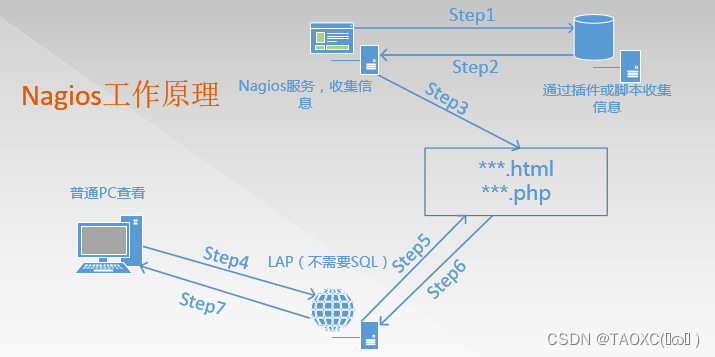
Nagios Server 采集数据,客户端就需要收集数据,Nagios采集数据加以分析,呈现给用户
两张比较经典的监控图

在大规模生产环境中,如果需要浏览历史数据,需要结合db
获取数据的方式:主动发送、NRPE插件、SNMP、NSClient++
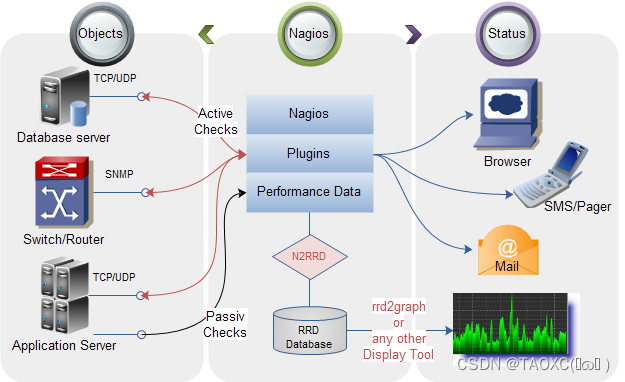
Nagios所需要的软件
LAMP环境,不需要mysql
nagios-3.5.1.tar.gz #Nagios核心文件,Nagios服务文件,不建议用最新,很多插件没做好
nagios-plugins-2.1.1.tar.gz #Nagios 插件,用于存放各种脚本和命令
NSCP-0.5.0 #也就是Nsclient++,用来监控Windows,分为64位和 32位版本
nrpe-2.15.tar.gz #代理服务,用于监控非Nagios服务器的服务器本地私有信息代理
部署Nagios监控服务器
部署之前,需要做好最基本的缓解,包括LAP环境的构建(这里直接使用yum方式安装即可,在做zabbix的时候我们需要使用我们编译的LNMP环境来做)
解决依赖和安装LAP环境
[root@taijitao63 ~]# yum install -y gcc glibc glibc-common php gd gd-devel libpng libmng libjpeg zlib
[root@taijitao63 ~]# yum install -y httpd ; systemctl restart httpd
[root@taijitao63 ~]# yum install http://mirrors.ustc.edu.cn/centos/6.7/os/x86_64/Packages/gd-devel-2.0.35-11.el6.x86_64.rpm
//部分镜像没有gd-devel这个软件包,去Centos镜像去拿下来,或者在线装
[root@taijitao63 ~]# echo "<?php phpinfo(); ?>" >/var/www/html/index.php //测试是否支持php

Nagios运行用户
[root@taijitao63 ~]# useradd nagios //建立Nagios用户,这里不能使用nologin的shell,nagios会用到
[root@taijitao63 ~]# groupadd nagcmd //建立一个组
[root@taijitao63 ~]# usermod -G nagcmd nagios //将Nagios和apache加入该组
[root@taijitao63 ~]# usermod -G nagcmd apache
Nagios核心安装
[root@taijitao63 ~]# mkdir Nagios //所有软件包放在此目录下
[root@taijitao63 ~]# cd Nagios ; ls
nagios-3.5.1.tar.gz nrpe-2.15.tar.gz
nagios-plugins-2.1.1.tar.gz vautour_style.zip
[root@taijitao63 Nagios]# tar xvf nagios-3.5.1.tar.gz -C /usr/local/src/
[root@taijitao63 Nagios]# cd /usr/local/src/nagios/
[root@taijitao63 nagios]# ./configure --with-command-group=nagcmd //指定Nagios运行用户组
……
General Options:
-------------------------
Nagios executable: nagios
Nagios user/group: nagios,nagios #运行用户
Command user/group: nagios,nagcmd #运行用户组
Embedded Perl: no
Event Broker: yes
Install ${prefix}: /usr/local/Nagios #默认安装到了/usr/local/nagios
Lock file: ${prefix}/var/nagios.lock
Check result directory: ${prefix}/var/spool/checkresults
Init directory: /etc/rc.d/init.d
Apache conf.d directory: /etc/httpd/conf.d #Apache的conf.d配置文件目录
Mail program: /bin/mail
Host OS: linux-gnu
Web Interface Options:
------------------------
HTML URL: http://localhost/nagios/ #登陆地址
CGI URL: http://localhost/nagios/cgi-bin/
Traceroute (used by WAP): /bin/traceroute
Review the options above for accuracy. If they look okay,
type 'make all' to compile the main program and CGIs.
[root@taijitao63 nagios]# make all //根据上面提示,Make all,下图出现,就无问题
** Compile finished ***
If the main program and CGIs compiled without any errors, you
can continue with installing Nagios as follows (type 'make'
without any arguments for a list of all possible options):
#下面已经提示安装步骤,我们就使用这个步骤来操作
make install
- This installs the main program, CGIs, and HTML files
make install-init
- This installs the init script in /etc/rc.d/init.d
make install-commandmode
- This installs and configures permissions on the
directory for holding the external command file
make install-config
- This installs *SAMPLE* config files in /usr/local/nagios/etc
You‘ll have to modify these sample files before you can
use Nagios. Read the HTML documentation for more info
on doing this. Pay particular attention to the docs on
object configuration files, as they determine what/how
things get monitored!
make install-webconf
- This installs the Apache config file for the Nagios
web interface
make install-exfoliation #主题相关,不需要安装
- This installs the Exfoliation theme for the Nagios
web interface
make install-classicui #主题相关,不需要安装,安装到web-conf就可以了
- This installs the classic theme for the Nagios
web interface
*** Support Notes *******************************************
If you have questions about configuring or running Nagios,
please make sure that you:
- Look at the sample config files
- Read the documentation on the Nagios Library at:
http://library.nagios.com
before you post a question to one of the mailing lists.
Also make sure to include pertinent information that could
help others help you. This might include:
- What version of Nagios you are using
- What version of the plugins you are using
- Relevant snippets from your config files
- Relevant error messages from the Nagios log file
For more information on obtaining support for Nagios, visit:
http://support.nagios.com
*************************************************************
Enjoy.
[root@taijitao63 nagios]# make install && make install-init && make install-commandmode && make install-config && make install-webconf //若是单步执行,每次执行一部,都会提示你下一步需要干什么,非常easy
//make install安装生成/usr/local/nagios/,其中/usr/local/nagios/share即nagiosWEB访问界面的站点目录
//make install-init 安装生成/etc/rc.d/init.d/nagios 启动脚本
//make install-config 安装生成/usr/local/nagios/etc下的nagios相关配置文件
//make install-commandmode 设定相应nagios工作目录的权限
//make install-webconf 安装Nagios的WEB配置文件到Apache的conf.d目录下
到此时,安装过程就结束了
Nagios文件熟悉
在安装的时候,make install时生存了share这个目录,这个目录是访问界面目录:
[root@taijitao63 nagios]# cd /root/Nagios ; ls /usr/local/nagios/share/
config.inc.php docs includes js media rss-corefeed.php side.php stylesheets
contexthelp images index.php main.php robots.txt rss-newsfeed.php ssi
在make install-init的时候,生存了启动脚本
[root@taijitao63 Nagios]# ls /etc/init.d/nagios
/etc/init.d/nagios #其实就是在/etc/rc.d/init.d/nagios
在make install-config的时候,生成了Nagios的相关配置文件
[root@taijitao63 Nagios]# ls /usr/local/nagios/etc/
cgi.cfg nagios.cfg objects resource.cfg
#包括以后安装了plugin等软件后,配置文件也会放入此目录
在make install-webconf的时候,已经把web-conf的相配置文件放入了/etc/httpd/conf.d/下面
[root@taijitao63 Nagios]# ls /etc/httpd/conf.d/nagios.conf
/etc/httpd/conf.d/nagios.conf #里面配置了一个别名,直接引用了/usr/local/nagios/share目录
[root@taijitao63 Nagios]# vim /etc/httpd/conf.d/nagios.conf
……
Alias /nagios "/usr/local/nagios/share"
Nagios主目录
[root@taijitao63 Nagios]# ll /usr/local/nagios/
bin #Nagios执行程序所在目录
etc #nagios配置文件坐在目录,初始安装只有几个*.cfg文件
libexec #监控所用命令,需要安装了nagios-plugins插件了才会有,检测命令,不装是空的
sbin #Nagios的Cgi文件所在目录,外部命令所需要的文件存放目录
share #Nagios前端页面
var #日志文件,pid文件等
Nagios前端访问测试
[root@taijitao63 Nagios]# service httpd restart
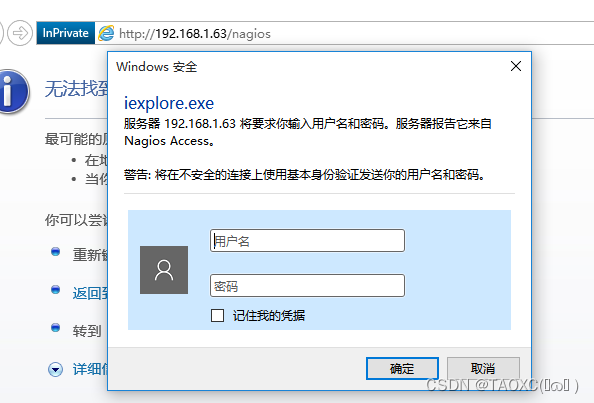
需要用户名和密码,查看vim /etc/httpd/conf.d/nagios.conf配置文件
[root@taijitao63 Nagios]# vim /etc/httpd/conf.d/nagios.conf
Alias /nagios "/usr/local/nagios/share"
<Directory "/usr/local/nagios/share">
# SSLRequireSSL
Options None
AllowOverride None
Order allow,deny
Allow from all
# Order deny,allow
# Deny from all
# Allow from 127.0.0.1
AuthName "Nagios Access" #这三个字段,就是访问nagios的认证用户名和密码相关配置
AuthType Basic
AuthUserFile /usr/local/nagios/etc/htpasswd.users
Require valid-user
</Directory>
在Directory字段里面有Auth这三个字段,那么就可以使用htpasswd来生成用户名和密码
[root@taijitao63 Nagios]# htpasswd -c /usr/local/nagios/etc/htpasswd.users nagiosadmin
-c表示创建,二次添加用户,不能使用-c参数
[root@taijitao63 Nagios]# cat /usr/local/nagios/etc/htpasswd.users
nagionsadmin:HQolRVjV67MiQ #密码
[root@taijitao63 Nagios]# service nagios restart //再次测试(我的用户名是nagiosadmin,密码123456) 目前只能监控本机 #centos7也是执行该条命令,没有找到service文件

但是现在还没有做任何深入配置,所以现在只是可以登录而已!
安装Nagios-plugins插件
Nagios-plugins含有丰富的检测命令插件,安装完成之后放在了/usr/local/Nagios/libexec下面
[root@taijitao63 Nagios]# tar xvf nagios-plugins-2.1.1.tar.gz -C /usr/local/src/
[root@taijitao63 Nagios]# cd /usr/local/src/nagios-plugins-2.1.1/
[root@taijitao63 nagios-plugins-2.1.1]# ./configure --with-nagios-user=nagios --with-nagios-group=nagcmd
[root@taijitao63 nagios-plugins-2.1.1]# make && make install ; cd /root/Nagios/
[root@taijitao63 Nagios]# ls /usr/local/nagios/libexec/ //已经有了很多check命令
check_apt check_ftp check_mailq check_oracle check_ssmtp
check_breeze check_http check_mrtg check_overcr check_swap
check_by_ssh check_icmp check_mrtgtraf check_pgsql check_tcp
check_clamd check_ide_smart check_mysql check_ping check_time
check_cluster check_ifoperstatus check_mysql_query check_pop check_udp
……
启动Nagios服务,检查环境
[root@taijitao63 Nagios]# systemctl restart httpd;systemctl restart nagios
浏览器测试:登陆之后,点击hosts,可以看到,默认监控的是本机,说明环境没有什么问题

Nagios监控本服务器
配置监控之前,我们需要做一系列的准备工作(指定主配置文件需要加载的配置文件—定义主机—定义服务 –定义监控命令—检查配置文件—启动Nagios)
[root@taijitao63 Nagios]# vim /usr/local/nagios/etc/nagios.cfg
log_file=/var/log/nagios/nagios.log #日志位置
cfg_file=/etc/nagios/objects/commands.cfg #这个文件定义了很多命令
cfg_file=/etc/nagios/objects/contacts.cfg #定义联系人,怎么联系
cfg_file=/etc/nagios/objects/timeperiods.cfg #定义了时间段
cfg_file=/etc/nagios/objects/templates.cfg #模板(联系人,主机,时间)
cfg_file=/etc/nagios/objects/localhost.cfg #监控本机相关配置文件
#cfg_file=/etc/nagios/objects/windows.cfg #windows,默认不监控
#cfg_file=/etc/nagios/objects/switch.cfg #交换机路由器监控,默认不监控
#cfg_file=/etc/nagios/objects/printer.cfg #打印机监控,默认不监控
#cfg_dir=/etc/nagios/servers #定义了服务合集(多个使用)
#cfg_dir=/etc/nagios/printers #定义了打印机合集(多个使用)
#cfg_dir=/etc/nagios/switches #定义了交换合集(多个使用)
#cfg_dir=/etc/nagios/routers #定义了路由合集(多个使用)
cfg_dir=/etc/nagios/conf.d #配置文件目录(下面的cfg文件一样有效)
resource_file=/etc/nagios/private/resource.cfg 资源变量配置文件,包括$USER1$变量(一个路径)等
status_update_interval=10 #状态更新时间,单位s
log_rotation_method=d #日志滚动,默认天
service_check_timeout=60 #服务检查超时时间
host_check_timeout=30 #主机检查超时时间
event_handler_timeout=30
notification_timeout=30
ocsp_timeout=5
perfdata_timeout=5
[root@taijitao63 Nagios]# vim /usr/local/nagios/etc/cgi.cfg //此配置文件比nagios.cfg优先级高
main_config_file=/etc/nagios/nagios.cfg #主配置文件
physical_html_path=/usr/share/nagios/html #物理路径
url_html_path=/nagios #在URL后面加上/nagios才能访问
use_authentication=1 #使用认证
use_ssl_authentication=0 #不使用ssl
authorized_for_system_information=nagiosadmin #认证用户
监控本地NFS状态
[root@taijitao63 Nagios]# cd /usr/local/nagios/etc/objects
[root@taijitao63 objects]# cp localhost.cfg localhost.cfg.bak //备份配置文件
[root@taijitao63 objects]# vim localhost.cfg
define service{
use local-service
host_name localhost
service_description NFS
check_command check_tcp!2049
}
[root@taijitao63 objects]# vim /etc/exports //创建一个共享
/tmp *(rw)
[root@taijitao63 objects]# /etc/init.d/nfs restart
[root@taijitao63 objects]# showmount -e 192.168.1.63 //检测NFS目前是否正常
Export list for 192.168.1.63:
/tmp *
检测localhost.cfg是否正常启用
[root@taijitao63 objects]# vim /usr/local/nagios/etc/nagios.cfg
cfg_file=/usr/local/nagios/etc/objects/localhost.cfg #localhost默认已经启用了
检测配置文件是否有误
[root@taijitao63 objects]# /usr/local/nagios/bin/nagios -v /usr/local/nagios/etc/nagios.cfg
Total Warnings: 0
Total Errors: 0
[root@taijitao63 objects]# service nagios restart //重启nagios服务
网页测试

正在检测,稍等一会儿

停止NFS服务
[root@taijitao63 objects]# service nfs stop //再观察
这里注意,一般没回立马又显示出来状态,需要一段时间,最好最快的方法就是手动强制刷新,否则你需要等待,强制刷新,点击NFS后有一个Re-schedule the next check of this service,强制刷新

可以看到状态了,一般状态有四种颜色,如下图:

Nagios监控远程MYSQL 数据库状态
Nagios:192.168.1.63 MySQL Server :192.168.1.64
taijitao64上安装msyql
[root@taijitao64 ~]# yum install -y mysql-server mysql
[root@taijitao64 ~]# service mysqld restart
[root@taijitao64 ~]# mysql //登陆创建一个测试数据库
mysql> create database nagiosdb;
mysql> grant select on nagiosdb.* to nagiosdb@'192.168.1.63';
mysql> exit
taijitao63上配置Nagios服务
[root@taijitao63 objects]# vim /usr/local/nagios/etc/nagios.cfg
# Definitions for monitoring the local (Linux) host
cfg_file=/usr/local/nagios/etc/objects/localhost.cfg #在这两行下面添加下面两行
cfg_file=/usr/local/nagios/etc/objects/hosts.cfg
cfg_file=/usr/local/nagios/etc/objects/service.cfg
[root@taijitao63 objects]# vim hosts.cfg
define host{
use linux-server #使用的模板名字
host_name taijitao64 #主机名
alias MySQL-Server #别名
address 192.168.1.64 #IP地址
icon_image server.gif #/usr/local/nagios/share/images/logos有各种图片
statusmap_image server.gd2 #状态图
2d_coords 500,200
3d_coords 500,200,100
}
[root@taijitao63 objects]# vim service.cfg
define service{
use local-service
host_name taijitao64
service_groups MysqlGroup
service_description MySqlSev
check_command check_mysql
}
define servicegroup{
servicegroup_name MysqlGroup
alias MySQLServer
members taijitao64,MySqlSev
}
[root@taijitao63 objects]# vim commands.cfg
define command{
command_name check_mysql
command_line $USER1$/check_mysql -H $HOSTADDRESS$ -u nagiosdb -d nagiosdb
}
注意:所有的check_command字段中的所使用的命令,必须在command.cfg中定义好才能使用,而command.cfg中的command_line中使用的命令,必须在/usr/local/Nagios/libexec/目录下存在,安装plugins会生成
手动检测command.cfg的命令有效性
[root@taijitao63 objects]# /usr/local/nagios/libexec/check_mysql -H 192.168.1.64 -u nagiosdb -d nagiosdb
Uptime: 1810 Threads: 1 Questions: 6 Slow queries: 0 Opens: 15 Flush tables: 1 Open tables: 8 Queries per second avg: 0.3|Connections=4c;;; Open_files=16;;; Open_tables=8;;; Qcache_free_memory=0;;; Qcache_hits=0c;;; Qcache_inserts=0c;;; Qcache_lowmem_prunes=0c;;; Qcache_not_cached=0c;;; Qcache_queries_in_cache=0;;; Queries=6c;;; Questions=6c;;; Table_locks_waited=0c;;; Threads_connected=1;;; Threads_running=1;;; Uptime=1810c;;;
[root@taijitao64 ~]# service mysqld stop //taijitao64停到服务再检测
[root@taijitao63 objects]# /usr/local/nagios/libexec/check_mysql -H 192.168.1.64 -u nagiosdb -d nagiosdb
can't connect to MySQL server on '192.168.1.64' (111)
前段测试
[root@taijitao63 objects]# service nagios restart
[root@taijitao64 ~]# service mysqld start


去停掉数据库[root@taijitao64 ~]# service mysqld stop
![]()
Nagios外部主机私有信息
私有信息,包括默认的硬盘使用,进程数目,SWAP分区等等
nrpe插件
通过NRPE(一个插件)服务可以添加本地信息的监控,将数据发送到我们的Nagios服务器
NRPE两部分组成,一部分是监控机check_nrpe,一部分是被监控机的NRPE守护进程
Nagios 服务器执行check_nrpe 插件并告诉他检查哪个服务,check_nrpe 插件通过SSL 连接方式联系远程服务器上的NRPE守护进程,NRPE守护进程执行相应的插件完成指定的检查,并返回结果。
nrpe工作原理
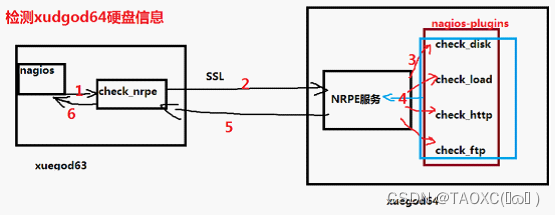
Nrpe是基于SSL的机制,那么我们需要做的事情就是构建SSL环境,所以需要使用NRPE工作的时候,都需要安装SSL,而且服务端和客户端都需要安装nrpe软件,而我们客户端不需要安装NAGIOS服务端
解决依赖
[root@taijitao63 Nagios]# yum install -y openssl openssl-devel
[root@taijitao64 ~]# yum install -y openssl openssl-devel
实验所需设备都需要安装SSL的支持
服务端安装NRPE
[root@taijitao63 Nagios]# tar xvf nrpe-2.15.tar.gz -C /usr/local/src/
[root@taijitao63 Nagios]# cd /usr/local/src/nrpe-2.15/
[root@taijitao63 nrpe-2.15]# ./configure && make && make install
[root@taijitao63 nrpe-2.15]# make install-plugin && make install-daemon
//前者安装插件,后者以守护经常来运行
[root@taijitao63 nrpe-2.15]# cd /root/Nagios/ ; ls /usr/local/nagios/libexec/check_nrpe
/usr/local/nagios/libexec/check_nrpe #这个命令需要安装nrpe之后才有
定义被监控主机
[root@taijitao63 Nagios]# cd /usr/local/nagios/etc/objects/
[root@taijitao63 objects]# vim hosts.cfg
define host{
use linux-server
host_name taijitao64
alias MySQL-Server
address 192.168.1.64
icon_image workstation.gif
statusmap_image workstation.gd2
2d_coords 500,200
3d_coords 500,200,100
}
#我们现在还是监控的taijitao64,所以信息不用更改
定义需要监控的服务
[root@taijitao63 objects]# vim service.cfg
define service{
use local-service
host_name taijitao64
service_description Root Partition
check_command check_nrpe!check_sda2 #/root分区
}
define service{
use local-service
host_name taijitao64
service_description Total Processes #进程总数
check_command check_nrpe!check_total_procs
}
define service{
use local-service
host_name taijitao64
service_description Current Load #负载
check_command check_nrpe!check_load
}
定义NRPE监控命令
[root@taijitao63 objects]# vim commands.cfg
define command{
command_name check_nrpe
command_line $USER1$/check_nrpe -H $HOSTADDRESS$ -c $ARG1$
}
[root@taijitao63 objects]# service nagios restart
客户端配置
[root@taijitao63 objects]# cd /root/Nagios/
[root@taijitao63 Nagios]# scp nagios-plugins-2.1.1.tar.gz nrpe-2.15.tar.gz root@192.168.1.64:/root
[root@taijitao64 ~]# useradd -s /sbin/nologin nagios
[root@taijitao64 ~]# groupadd nagcmd
[root@taijitao64 ~]# usermod -G nagcmd nagios
[root@taijitao64 ~]# tar xvf nagios-plugins-2.1.1.tar.gz -C /usr/local/src/
[root@taijitao64 ~]# tar xvf nrpe-2.15.tar.gz -C /usr/local/src/
[root@taijitao64 ~]# cd /usr/local/src/nagios-plugins-2.1.1/
[root@taijitao64 nagios-plugins-2.1.1]# ./configure && make && make install
[root@taijitao64 nagios-plugins-2.1.1]# cd ../nrpe-2.15/
[root@taijitao64 nrpe-2.15]# ./configure && make && make install
[root@taijitao64 nrpe-2.15]# make install-daemon-config //这里是客户端,不用make-install-plugin,非提示操作
[root@taijitao64 nrpe-2.15]# make install-xinetd
[root@taijitao64 nrpe-2.15]# yum install -y xinetd ; cd
[root@taijitao64 ~]# vim /etc/xinetd.d/nrpe
# default: on
# description: NRPE (Nagios Remote Plugin Executor)
service nrpe
{
flags = REUSE
socket_type = stream
port = 5666
wait = no
user = nagios
group = nagios
server = /usr/local/nagios/bin/nrpe
server_args = -c /usr/local/nagios/etc/nrpe.cfg --inetd
log_on_failure += USERID
disable = no
only_from = 127.0.0.1 192.168.1.63 # #添加红色 nagios服务器地址, 允许235这台机器来连接自己的nrpe服务,多个IP地址空格分隔
}
[root@taijitao64 ~]# vim /etc/services //端口注册
nrpe 5666/tcp # NRPE
#/etc/services文件的作用:
#作用1:xinet.d来启动服务时他就会在/etc/services找相应服务对应的端口来启动服务。找不到对应端口,将不启动服务。
#作用2: 显示对应端口对应的协议名。
#例如 iptables -L 不加-n参数, 查看时,把 80转 -> www http
#作用3: 查看常用端口
[root@taijitao64 ~]# /etc/init.d/xinetd restart
[root@taijitao64 ~]# chkconfig xinetd on
[root@taijitao64 ~]# netstat -antup | grep 5666
tcp 0 0 :::5666 :::* LISTEN 68667/xinetd
客户端nrpe命令
[root@taijitao64 ~]# vim /usr/local/nagios/etc/nrpe.cfg
command[check_sda1]=/usr/local/nagios/libexec/check_disk -w 38% -c 35% -p /dev/sda1
command[check_sda2]=/usr/local/nagios/libexec/check_disk -w 42% -c 43% -p /dev/sda2
command[check_swap]=/usr/local/nagios/libexec/check_swap -w 20% -c 10%
#-w为警告 -C为告急 sda2中,我们是指占用42%
[root@taijitao64 ~]# service xinetd restart
服务端手动测试
[root@taijitao63 Nagios]# /usr/local/nagios/libexec/check_nrpe -H 192.168.1.64
NRPE v2.15
#如果出现以一下错误,说明没有允许192.168.1.63 访问我们的64服务器
#CHECK_NRPE: Error - Could not complete SSL handshake.
#我们需要检查/etc/init.d/nrpe 下面的only from中的有无添加
root@taijitao63 Nagios]# service nagios restart
前端监控

测试:硬盘数据写入测试,看看root partition会不会告急
[root@taijitao64 ~]# dd if=/dev/zero of=1.txt count=100 bs=30M

[root@taijitao64 ~]# rm -rf * //清除这些临时测试文件
配置邮件报警
root@taijitao63 Nagios]# yum install -y sendmail
[root@taijitao63 Nagios]# /etc/init.d/sendmail start
[root@taijitao63 Nagios]# chkconfig sendmail on
[root@taijitao63 Nagios]# cd /usr/local/nagios/etc/objects/
[root@taijitao63 objects]# vim contacts.cfg
define contact{
contact_name nagiosadmin
use generic-contact
alias Nagios Admin
email nagiostest@163.com #修改为自己的邮箱
}
[root@taijitao63 objects]# service nagios restart
[root@taijitao64 ~]# service mysqld restart //taijitao64上的数据库启动

[root@taijitao64 ~]# /etc/init.d/mysqld stop //然后再停掉,测试能否触发邮件
点击![]() 强制检测,避免时间等待
强制检测,避免时间等待

查看邮件
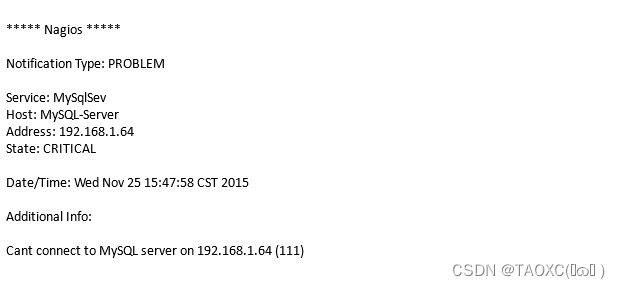
若要使用短信报警,可以配139邮件或者其他有短信提醒功能的邮件
安装PNP4Nagios
pnp4nagios是一款强大的工具,它可以通过process_perfdata.pl脚本调用rrdtool对nagios的性能数据进行分析并绘制成相应的性能图。Pnp4nagios使用的是RRDtool工具来实现画图的
依赖解决
[root@taijitao63 Nagios]# yum install -y rrdtool php-gd
[root@taijitao63 Nagios]# tar xvf pnp4nagios-0.6.25.tar.gz
[root@taijitao63 Nagios]# cd pnp4nagios-0.6.25
[root@taijitao63 pnp4nagios-0.6.25]# ./configure --prefix=/usr/local/pnp4nagios --with-nagios-user=nagios --with-nagios-group=nagcmd
[root@taijitao63 pnp4nagios-0.6.25]# make all && make install && make install-webconf && make install-config && make install-init
[root@taijitao63 pnp4nagios-0.6.25]# make fullinstall
配置pnp4naigos和nagios整合
[root@taijitao63 pnp4nagios]# vim /usr/local/nagios/etc/nagios.cfg
#修改以下几个内容
...
process_performance_data=1 #修改
...
host_perfdata_command=process-host-perfdata #取消注释
service_perfdata_command=process-service-perfdata
...
[root@taijitao63 pnp4nagios]# vim /usr/local/nagios/etc/objects/commands.cfg
# 'process-host-perfdata' command definition 次行在原有基础上修改,要么将上面的同名4行注释
define command{
command_name process-host-perfdata
command_line /usr/local/pnp4nagios/libexec/process_perfdata.pl -d HOSTPERFDATA
}
# 'process-service-perfdata' command definition 次行在原有基础上修改,要么将上面的同名4行注释
define command{
command_name process-service-perfdata
command_line /usr/local/pnp4nagios/libexec/process_perfdata.pl
}
[root@taijitao63 pnp4nagios]# vim /usr/local/nagios/etc/objects/templates.cfg
define host {
name host-pnp
action_url /pnp4nagios/index.php/graph?host=$HOSTNAME$' class='tips' rel='/pnp4nagios/index.php/popup?host=$HOSTNAME$&srv=_HOST_
register 0
#process_perf_data 1
}
define service {
name srv-pnp
action_url /pnp4nagios/index.php/graph?host=$HOSTNAME$&srv=$SERVICEDESC$' class='tips' rel='/pnp4nagios/index.php/popup?host=$HOSTNAME$&srv=$SERVICEDESC$
register 0
#process_perf_data 1
}
[root@taijitao63 pnp4nagios]# cp ~/Nagios/pnp4nagios-0.6.25/contrib/ssi/status-header.ssi /usr/local/nagios/share/ssi/
[root@taijitao63 pnp4nagios]# vim /usr/local/nagios/etc/objects/localhost.cfg
use linux-server,host-pnp ; Name of host template to use
#or
use local-service,srv-pnp ; Name of service #每一行加上,那么每一个服务就会有一个图标
[root@taijitao63 pnp4nagios]# mv /usr/local/pnp4nagios/share/install.php /usr/local/pnp4nagios/share/install.php.bak
[root@taijitao63 pnp4nagios]# chown -R nagios:nagios /var/www/html/ /usr/local/nagios/ /usr/local/pnp4nagios/
[root@taijitao63 pnp4nagios]# service nagios restart;service httpd restart; service npcd start
启动服务
[root@taijitao63 check_commands]# /etc/init.d/npcd restart
配置nagios结合php4nagios
[root@taijitao63 check_commands]# cd /usr/local/nagios/etc/
[root@taijitao63 etc]# vim nagios.cfg
process_performance_data=1
host_perfdata_command=process-host-perfdata
service_perfdata_command=process-service-perfdata
[root@taijitao63 etc]# vim /usr/local/nagios/etc/objects/commands.cfg
[root@taijitao63 etc]# cd /usr/local/nagios/etc/objects/
[root@taijitao63 objects]# vim templates.cfg
define host{
name host-pnp
action_url /php4nagios/graph?host=$HOSTNAME$&srv=_HOST_
register 0
}
define service{
name srv-php
action_url /php4nagios/graph?host=$HOSTNAME$&srv=$SERVICEDESC$
register 0
}
[root@taijitao63 objects]# vim commands.cfg //下面的修改
# 'process-host-perfdata' command definition
define command{
command_name process-host-perfdata
command_line /usr/local/php4nagios/libexec/process_perfdata.pl -d HOSTPERFDATA
}
# 'process-service-perfdata' command definition
define command{
command_name process-service-perfdata
command_line /usr/local/php4nagios/libexec/process_perfdata.pl
[root@taijitao63 objects]# cd /root/Nagios/pnp4nagios-0.6.25/contrib/ssi/
[root@taijitao63 ssi]# cp status-header.ssi /usr/local/nagios/share/ssi/
测试
浏览器访问测试:192.168.1.63/Nagios

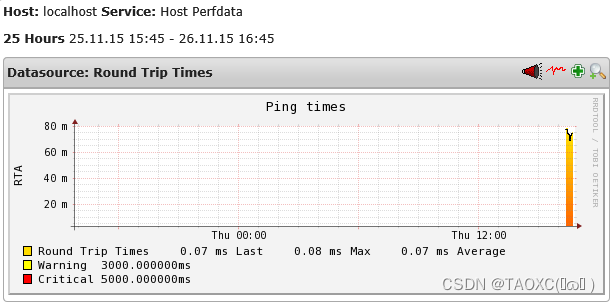

拓展
以下步骤可以不做,但是做了更科学
[root@taijitao63 pnp4nagios-0.6.25]# cd /usr/local/pnp4nagios/etc/
[root@taijitao63 etc]# mv misccommands.cfg-sample misccommands.cfg
[root@taijitao63 etc]# mv nagios.cfg-sample nagios.cfg
[root@taijitao63 etc]# mv rra.cfg-sample rra.cfg
[root@taijitao63 etc]# cd pages/
[root@taijitao63 pages]# mv web_traffic.cfg-sample web_traffic.cfg
[root@taijitao63 pages]# cd ../check_commands/
[root@taijitao63 check_commands]# mv check_all_local_disks.cfg-sample check_all_local_disks.cfg
[root@taijitao63 check_commands]# mv check_nrpe.cfg-sample check_nrpe.cfg
[root@taijitao63 check_commands]# mv check_nwstat.cfg-sample check_nwstat.cfg
Windows主机监控
Nagios中文帮助:sourceforget.net - //若打不开FQ
监控Windows
# vim /etc/nagios/nagios.cfg
cfg_file=/etc/nagios/objects/windows.cfg #取消注释
# vim /etc/nagios/objects/windows.cfg
define host{
use windows-server
host_name winserver
alias My Windows Server
address 192.168.1.55 #修改此项地址为Windowsip地址
}
其余的,更具需求选择需要监控的内容
在windows 上安装NSCP软件,根据提示下一步即可
相关文章
- [linux]磁盘监控程序并且发EMail
- [linux]Linux下的log
- Linux监控工具介绍系列——free`
- Linux下安装配置Nexus
- Linux常用命令记录
- linux crontab 文件位置和日志位置
- 【Linux基础】linux下修改ls显示的时间格式
- Linux基础之linux服务器服务器间拷贝文件
- Qt编写安防视频监控系统(支持win/linux/mac/海康/大华/宇视/264/265等)
- Alpine Linux 中的 apk 命令讲解
- Linux服务集群部署实战--MySQL、Redis、ES、RocketMQ、Zookeeper
- 成功解决解决VM软件安装Linux的Ubuntu过程,打开时 Operating System not found
- Linux从零开始(一、安装系统)
- 【Linux 内核】编译 Linux 内核 ② ( 解压内核源码 | 查询当前 Linux 内核版本号 | 进入并查看 linux 内核源码目录 )
- Linux linux echo命令的-n、-e两个参数
- Linux下把目录拷贝到全部同名目录的脚本
- L45.linux命令每日一练 -- 第七章 Linux用户管理及用户信息查询命令 -- sudo和id
- L44.linux命令每日一练 -- 第七章 Linux用户管理及用户信息查询命令 -- su和visudo
- 嵌入式Linux开发,Ubuntu22下交叉编译报错:arch64-linux-gnu-gcc: error while loading shared libraries: libstdc++.so.
- 嵌入式linux开启无线热点模式(AP),联机设备通过 wifi 热点访问外网
- linux 宽带监控
- Linux chmod命令具体解释
- 记一次与挖矿木马的较量---linux下的挖矿
- RK3399平台开发系列讲解(网络篇)7.10、Linux网络包接收过程的监控
- 006_Nacos注册中心【Windows和Linux安装Nacos】
- Kafka集群安装部署(超详细操作演示)—— Linux
- Linux pidstat对运行进程实时监控
- 02 从头开始atac项目 ubuntu20 install r4.2 Linux系统环境配置 服务器版本的rstudio r install in linux /ubuntu/centos
- Linux基础入门到精通之虚拟机管理技巧(快照、克隆)

